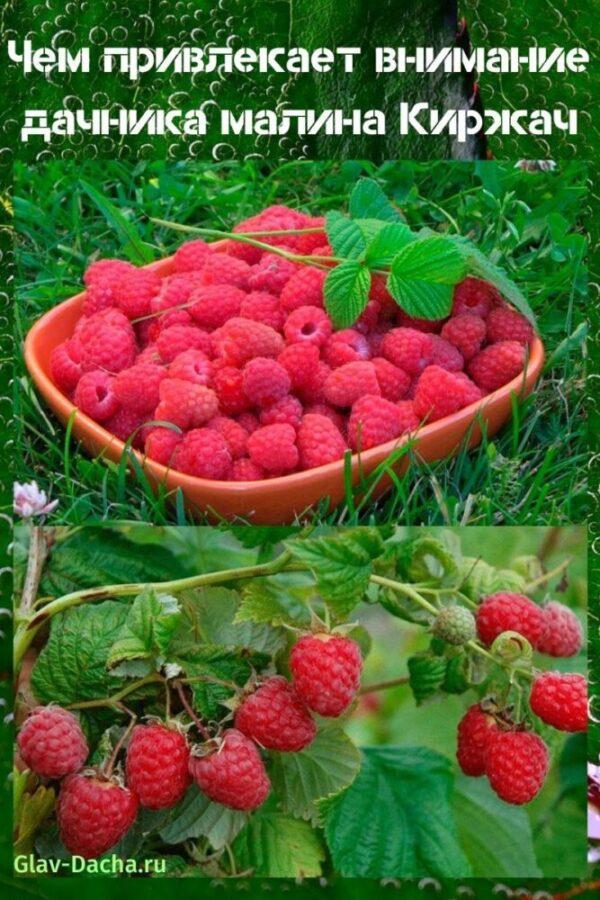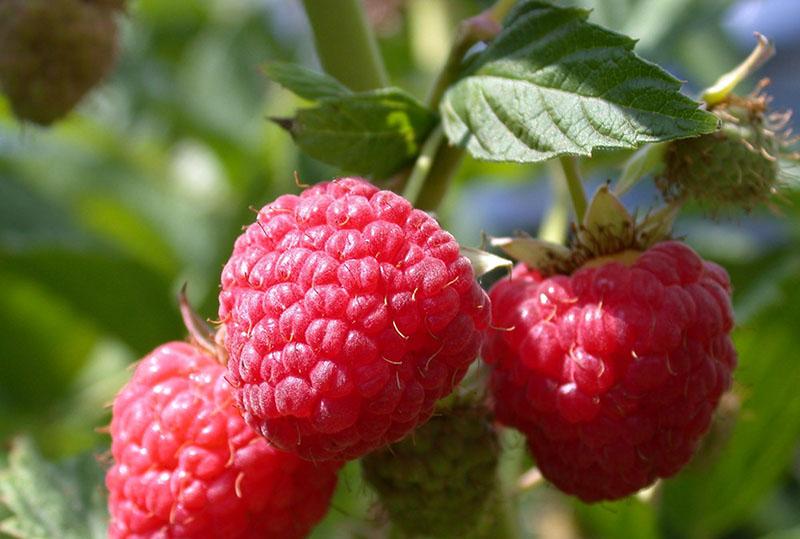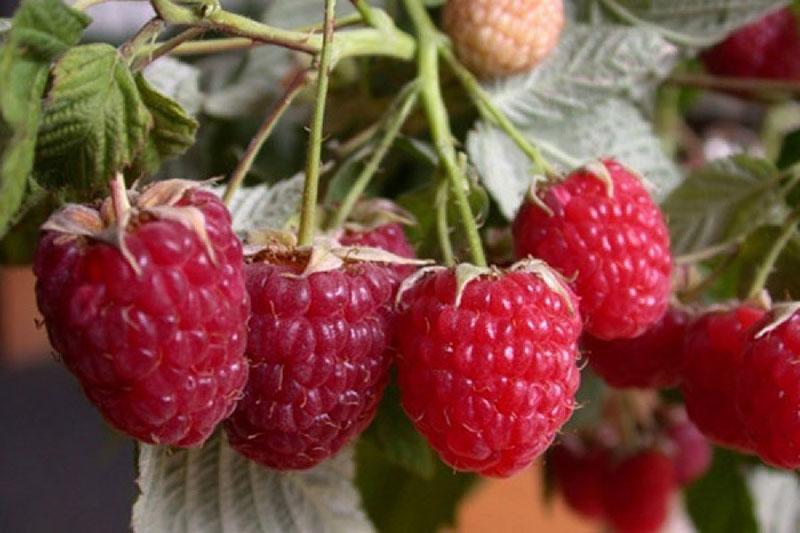What attracts the attention of the summer resident raspberry Kirzhach
 Raspberry Kirzhach belongs to mid-season varieties. It was bred in the experimental fields of the national breeding institute as a result of crossing the varieties Moling Promis and Carnival. Although the variety does not impress with its very high yield, it is appreciated for its unpretentiousness. The plant inherited the ability to adapt to various agro-climatic conditions from the parental forms.
Raspberry Kirzhach belongs to mid-season varieties. It was bred in the experimental fields of the national breeding institute as a result of crossing the varieties Moling Promis and Carnival. Although the variety does not impress with its very high yield, it is appreciated for its unpretentiousness. The plant inherited the ability to adapt to various agro-climatic conditions from the parental forms.
What is special about raspberry Kirzhach

Plants are represented by branched bushes formed by strong erect shoots. Shoot formation intensity is high. In the description of the Kirzhach raspberry variety, the originators note that with proper agricultural technology, the plant is capable of forming up to 25 stems. If the newly formed shoots have a characteristic waxy bloom, then by autumn they become reddish. Stems covered with large, wrinkled oval-shaped leaf blades
 During the fruiting period, the shoots are harvested of bright red conical berries with a blunt tip. Although they get rid of the stalk easily, the fruits keep on the shoots for a long time. Spontaneous shedding is noted only with severe overripe. The pulp is juicy with a sweet-sour taste. The scent is barely perceptible.
During the fruiting period, the shoots are harvested of bright red conical berries with a blunt tip. Although they get rid of the stalk easily, the fruits keep on the shoots for a long time. Spontaneous shedding is noted only with severe overripe. The pulp is juicy with a sweet-sour taste. The scent is barely perceptible.
The Kirzhach raspberry variety is appreciated for the high commercial quality of berries. They are easy-to-use, tolerate transportation well.
Planting raspberries
 Raspberries Kirzhach are planted in two terms: in spring and autumn. The decisive factor is the agro-climatic characteristics of the growing region. In the middle lane and southern regions, the optimal time is the first half of autumn. Before the first frost, the seedlings have time to take root, and in the spring they immediately grow. In cooler regions, preference is given to spring planting, since due to the sudden arrival of cold weather, there is a high risk of freezing of immature plants.
Raspberries Kirzhach are planted in two terms: in spring and autumn. The decisive factor is the agro-climatic characteristics of the growing region. In the middle lane and southern regions, the optimal time is the first half of autumn. Before the first frost, the seedlings have time to take root, and in the spring they immediately grow. In cooler regions, preference is given to spring planting, since due to the sudden arrival of cold weather, there is a high risk of freezing of immature plants.
Site selection and soil preparation
 Well-lit places where legumes or grain crops were previously cultivated are allotted for laying the berry. Planting in the shade will result in strong stretching of the shoots and a significant decrease in yield. The site must be protected from drafts and north winds. If the groundwater is high on the site, it is better to choose a hill or organize raised beds.
Well-lit places where legumes or grain crops were previously cultivated are allotted for laying the berry. Planting in the shade will result in strong stretching of the shoots and a significant decrease in yield. The site must be protected from drafts and north winds. If the groundwater is high on the site, it is better to choose a hill or organize raised beds.
The raspberry variety Kirzhach grows well on neutral and slightly acidic soils.
The soil is prepared in advance. To increase aeration, compost is added for digging or humusthat loosen the soil. With a depleted composition, complete complex fertilizers in the form of azofoska are additionally laid. To increase acidity, high-moor peat or superphosphate is used. In the latter case, the concentration of phosphorus in the soil composition is taken into account (to avoid an overabundance). Lime or dolomite flour is used for deoxidation.
Landing technology

With the arrival of the optimal time, the main work begins. Sequence of steps:
- The roots of the seedlings are treated with wood ash to protect against bacterial and fungal diseases.
- Dig the planting holes in accordance with the root system of the seedlings.
- The distance between the holes is kept about 35 cm in a row. Row spacing - 55 cm.
- Prepare a substrate from sand and humus.
- Seedlings are placed at the bottom of the pit and the roots are sprinkled with soil mixture.
- After light compaction, the soil in the near-trunk circles is covered with mulch, which is straw or sawdust.
Berry care
 Despite its unpretentiousness, the raspberry tree needs to be regularly looked after. This will ensure stable fruiting. The berries will be large and juicy every year. Agricultural technology is standard and includes watering, fertilization. In addition, pruning, phytosanitary control and preparation for winter are important, since Kirzhach is not a remontant raspberry and only yields on last year's shoots.
Despite its unpretentiousness, the raspberry tree needs to be regularly looked after. This will ensure stable fruiting. The berries will be large and juicy every year. Agricultural technology is standard and includes watering, fertilization. In addition, pruning, phytosanitary control and preparation for winter are important, since Kirzhach is not a remontant raspberry and only yields on last year's shoots.
Watering and feeding
 The berry is able to tolerate drought, but when there is a lack of moisture, it starts up a lot of growth. The latter contributes to the extraction of the necessary liquid from a vast territory. As a result, the development of the vegetative mass occurs to the detriment of fruit formation. To achieve maximum productivity, the shrub is regularly watered. The soil layer should be soaked to a depth of 30 cm. After watering, in order to avoid the formation of an airtight crust, the soil under the bites is loosened. Weeds are removed at the same time. To ensure that water flows under the bushes in a dosed manner and does not form a crust, a drip irrigation system is used.
The berry is able to tolerate drought, but when there is a lack of moisture, it starts up a lot of growth. The latter contributes to the extraction of the necessary liquid from a vast territory. As a result, the development of the vegetative mass occurs to the detriment of fruit formation. To achieve maximum productivity, the shrub is regularly watered. The soil layer should be soaked to a depth of 30 cm. After watering, in order to avoid the formation of an airtight crust, the soil under the bites is loosened. Weeds are removed at the same time. To ensure that water flows under the bushes in a dosed manner and does not form a crust, a drip irrigation system is used.
A high-quality and abundant harvest over several years is the result of a balanced diet. It can be provided with organic and mineral fertilizers.
At least 4 procedures are carried out per season:
- In the spring, while loosening the soil, a mullein is introduced with a consumption rate of 8 kg / m2... They also use urea, which strengthens plant immunity. The solution is prepared from 10 l of water and 20 g of the drug.
- In the flowering phase, fertilizing watering is carried out using boric acid - 20 g per bucket of water.
- During the period of fruit formation, a complex mineral fertilizer is introduced into the dressings - 30 g of azofoska per 10 liters of water.
- In preparation for winter, superphosphate and potassium sulfate are laid around the bushes for digging at the rate of 20 g and 15 g, respectively. Then the area is watered.
Pruning
 The pruning method depends on the planting pattern. If the berry is planted by the bush method, no more than 10 shoots are kept on one copy. Otherwise, the planting will be too thick and will create a favorable microclimate for the development of fungal diseases. Plants that are planted in rows are pruned so that the distance between the specimens is about 10 cm.
The pruning method depends on the planting pattern. If the berry is planted by the bush method, no more than 10 shoots are kept on one copy. Otherwise, the planting will be too thick and will create a favorable microclimate for the development of fungal diseases. Plants that are planted in rows are pruned so that the distance between the specimens is about 10 cm.
All dry and old shoots are cut at the root. The remaining hemp can become a source of infection, which will infect healthy specimens with the arrival of spring. Branches with signs of disease are shortened to areas with healthy tissue.
In case of very dense vegetation, healthy shoots are also pruned, preventing the berries from crumbling.
Shelter
 In order for raspberries to successfully winter, the root system must be protected. In regions with warm winters, before the onset of cold weather, it is enough to cover the beds with a layer of mulch. The optimum thickness is 10-15 cm. In the northern regions, Kirzhach raspberries require serious protection. The layer of mulch is made thicker - 25 cm. In addition, the shoots are bent to the ground. They are first tied with a rope and lowered to the soil. After bending down, raspberries should not rise more than half a meter above the soil level. Over time, the above-ground part will be covered with a thick layer of snow, which acts as an excellent natural protection against freezing. If winters with little snow prevail in the region, then raspberries are protected with the help of artificial material. Use non-woven covering material,
In order for raspberries to successfully winter, the root system must be protected. In regions with warm winters, before the onset of cold weather, it is enough to cover the beds with a layer of mulch. The optimum thickness is 10-15 cm. In the northern regions, Kirzhach raspberries require serious protection. The layer of mulch is made thicker - 25 cm. In addition, the shoots are bent to the ground. They are first tied with a rope and lowered to the soil. After bending down, raspberries should not rise more than half a meter above the soil level. Over time, the above-ground part will be covered with a thick layer of snow, which acts as an excellent natural protection against freezing. If winters with little snow prevail in the region, then raspberries are protected with the help of artificial material. Use non-woven covering material,
Correct planting and caring for the Kirzhach raspberry variety is the key to stable and rich yields. And they practically will not take away time and effort from the gardener, for which they value the berry.